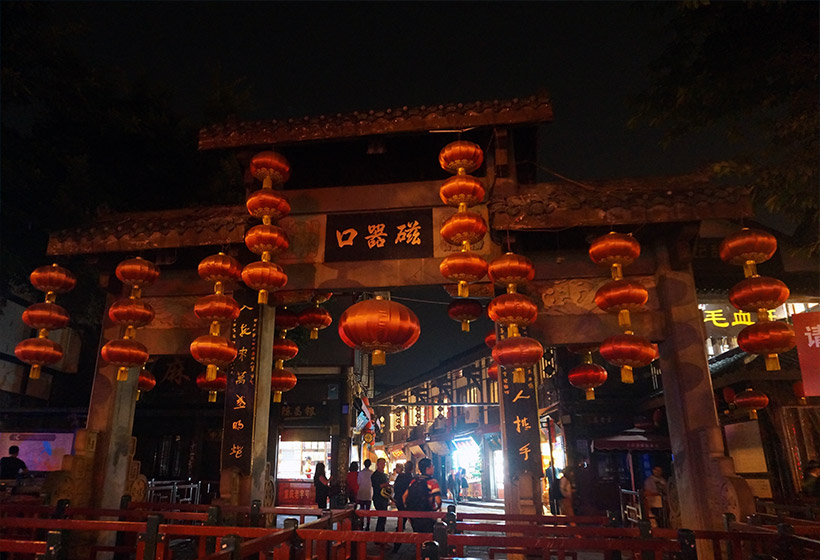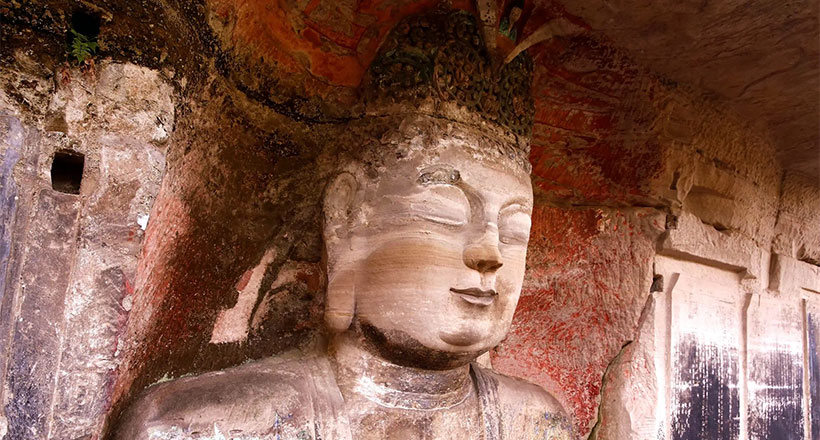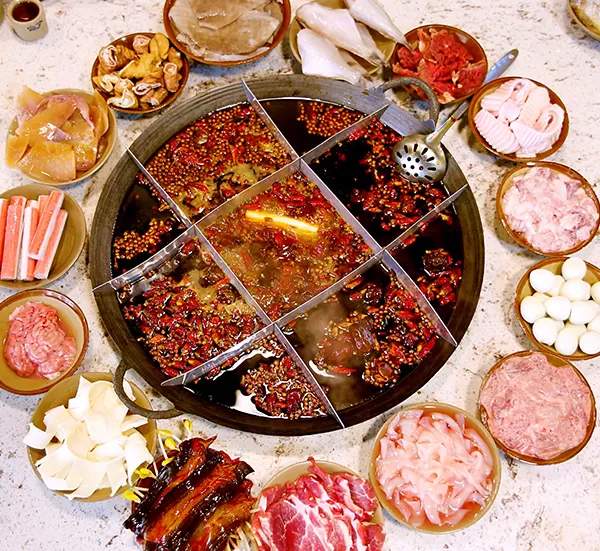Top 10 Famous Tourist Attractions and Sightseeing in Chongqing
In the fog city and mountain city of Chongqing, every bridge and alley hides endless stories. As a city that blends modern urban charm with ancient Bayu culture, Chongqing boasts so many tourist attractions that they dazzle the eyes. Here are the Chongqing top 10 attractions.
Top 1: Hongya Cave
Hongya Cave, also known as Hongyan Cave, is officially named the Hongya Cave Folk Custom and Cultural Area. It is a tourist destination that integrates sightseeing, leisure, and vacation experiences. Located along the riverside at the confluence of the Yangtze River and the Jialing River, Hongya Cave spans 11 floors, reaches a height of 79 meters, and covers a total area of 31,500 square meters. It boasts a history of over 2,300 years.
What captures the eye is the striking cluster of stilted buildings illuminated by fantastical lights. Distinct from the stilted houses of the Dai people in Xishuangbanna, these structures belong to a railing-style architecture, a traditional residential design unique to the southwest region of China, dating as far back as before the Eastern Han dynasty. Due to Chongqing's mountainous terrain and limited land space, ancestors adapted to the environment by constructing wooden and bamboo-framed houses that are suspended over steep cliffs. These houses are built along the slopes, against the cliffs, and beside rivers—features that make Chongqing’s stilted buildings truly distinctive.
The stilted building complex of Hongya Cave faithfully recreates the ancient charm of the old Bayu capital. It showcases the most iconic elements of old Chongqing, including stilted houses, traditional archways, overhanging beams, carved corridors, hillside marketplaces, and flagstone roads, building the 11-storeys stilted structure cluster into the cliffs. Hence it has earned the nickname "China’s Cliff City" within architectural circles, and the media has dubbed it " City in the Sky".
As night falls, countless lights illuminate there, casting the glow upon the Jialing River and the mountain city, transforming it into a resplendent palace embedded in the cliff. Here, history intertwines with modernity, tradition blends with innovation, weaving a dreamlike spectacle that captivates the soul.
- Address: No. 88 Binjiang Road, Jialing River, Yuzhong District, Chongqing
- Open Hours: 11:00 AM – 11:00 PM
- Tour Length: 2-6 hours
Top 2: Ciqikou Ancient Town
 Ciqikou Ancient Town
Ciqikou Ancient TownCiqikou Ancient Town, originally named Baiyan Field and also known as Longyin Town, is located 14 kilometers north of downtown Chongqing. The ancient town covers a total area of 325,000 square meters, with the core scenic area stretching across the east and southeast slopes of Ma’an Mountain, occupying 143,000 square meters. First built during the Song Dynasty, it has a history of more than 1,800 years. It is the largest and most representative ancient town within Chongqing’s main urban area, showcasing the traditional residences, customs, and culture of the Bayu region. Once a thriving river and land transportation hub, Ciqikou rose to prominence through porcelain trade, and today it has regained popularity through the rise of ancient town tourism.
The town’s traditional residential architecture, stone steps and alleyways, and preserved temples and Taoist sanctuaries make it a natural museum of Bayu mountain-style dwellings. Built along the mountain, the town ascends with the terrain. Centered around Ciqikou’s main street and cross street, 42 lanes branch out perpendicularly toward the Ma’an Mountain ridge and streamside, forming a distinctive tree-branch-like layout.
Walking along the winding stone-paved roads, one feels the touch of time on the centuries-old structures lining the path—still bustling today, full of dazzling shops, with the aroma of tea, the scent of fried mahua, and the calls of street vendors rising and falling in harmony. The liveliness here never feels overwhelming—instead, it’s like being gently swept into an eternal temple fair that never ends.
- Address: No. 1, Cinan Street, Shapingba District, Chongqing
- Open Hours: 00:00 AM – 12:00 PM
- Tour Length: 2-6 hours
Top 3: Three Natural Bridges
Wulong's Three Natural Bridges are located between Fairy Mountain and Wulong District. Within the scenic area, the natural stone bridges are grand and majestic, surrounded by lush forests and cascading waterfalls. The Three Natural Bridges—Tianlong Bridge, Qinglong Bridge, and Heilong Bridge—are known for their immense scale and awe-inspiring grandeur, making them the largest natural bridge cluster in Asia. Each bridge spans more than 150 meters in height, 200 meters in width, and 300 meters in length. Arranged longitudinally, the three bridges lie parallel to each other, stretching across the Yangshui River Gorge and connecting the mountains on both sides, forming a unique landscape of "three bridges with two sinkholes".
Having three such massive natural stone arch bridges within just a few hundred meters is extremely rare in China and rare even on a global scale, which is a natural treasure gifted to humanity. Walking along the serene path to the base of the bridges offers a deeper appreciation of their majesty and grandeur, evoking awe at the wonder of nature’s creation. The bridge bodies are surrounded by caves, with water curtains hanging from above. Beneath the bridges, streams flow gently and fountains babble. Dense forests, verdant peaks, towering cliffs, and sheer walls stand tall. Green grass carpets the ground, slender bamboo sways in the breeze, and waterfalls flow freely, creating a magnificent, vigorous, mysterious, and serene primitive natural landscape. Mountains, rivers, waterfalls, gorges, caves, and bridges come together to form a perfect natural scroll painting.
- Address: 20 kilometers southeast of Wulong District, Chongqing
- Open Hours: 08:30 AM – 05:00 PM
- Tour Length: 2-6 hours
Top 4: Liberation Monument
The War Victory Monument and People's Liberation Monument, short for the "Liberation Monument", is located at the center of the Liberation Monument Commercial Pedestrian Street in Chongqing. It serves as a spiritual symbol of victory in the War of Resistance and is the only monument in China dedicated to commemorating the Chinese nation's victory in the War of Resistance Against Japanese Aggression.
The monument faces slightly northeast and features an eight-sided column with a dome-shaped top, constructed of reinforced concrete. Standing 27.5 meters tall with 2.55-meter-long sides, it comprises eight floors including underground levels, connected by a spiral staircase leading to the summit. The top of the monument is equipped with a self-ringing bell in the direction of the four street entrances, while flower beds surround the 62-square-meter base platform.
Centered around the monument, Liberation Monument Pedestrian Street extends in all directions, paved with 400,000 granite tiles, and is the first commercial pedestrian street in western China. Walking along the pedestrian street, visitors are drawn to the dazzling array of goods on display. From international brands to local specialties, from trendy clothing to exquisite accessories—everything can be found here. At night, the street becomes even more vibrant, lit up with brilliant lights and flashing neon signs, presenting a scene of bustling prosperity.
- Address: No. 177 Minzu Road, Yuzhong District, Chongqing
- Open Hours: 00:00 AM – 12:00 PM
- Tour Length: 1-4 hours
Top 5: Dazu Rock Carvings
 Dazu Rock Carvings
Dazu Rock CarvingsThe Dazu Rock Carvings, located in Dazu District of Chongqing, refer collectively to 141 cliffside sculptural sites within the district. These carvings total over 50,000 statues, with the majority centered on Buddhist themes, followed by Taoist subjects. The carvings primarily consist of high and low reliefs, with a smaller number of sculptures in the round and a few line engravings. The Dazu Rock Carvings are regarded alongside the Yungang Grottoes in Shanxi Datong, the Longmen Grottoes in Henan Luoyang, and the Mogao Caves in Gansu Dunhuang.
The carving began in the early Tang Dynasty, continued through the late Tang and Five Dynasties period, flourished during the Song Dynasty, and saw further additions in the Ming and Qing dynasties ultimately forming a monumental complex that epitomizes the hallmark of late-period grotto art in China. The Dazu Rock Carvings are world-renowned for their grand scale, exquisite craftsmanship, diversity of themes, rich connotations, and excellent preservation.
Among the most distinctive grottoes are those at North Mountain, Baoding Mountain, South Mountain, Shimen Mountain, and Shizhuan Mountain. There is the Thousand-Hand Guanyin statue, hailed as a “national treasure among national treasures”, which resembles a peacock spreading its feathers. Also here is the world’s largest half reclining Buddha sculpture depicting the Nirvana of Shakyamuni, with the feet tucked into the rock and the right shoulder sinking into the ground, sparking endless imagination. These gracefully approaching artistic treasures will linger in your memory.
- Address: No. 7 Beishan Road, Dazu District, Chongqing
- Open Hours: 09:00 AM – 06:00 PM
- Tour Length: 2-4 hours
Top 6: Yangtze River Cableway
The Yangtze River Cableway spans the Yangtze River, connecting Chongqing’s Yuzhong District and Nan’an District. The scenic area consists of three main parts: the Yuzhong Urban History and Culture Zone, the Yangtze River Aerial Sightseeing Zone, and the Nan’an Film and Culture Zone, covering a total area of 9.8 square kilometers, with the length of 1,166 meters.
As the first aerial corridor over the Yangtze River, the Yangtze River Cableway has been in operation for more than thirty years. Day after day, year after year, it travels from one bank to the other, becoming the longest-playing classic old song in the sky above the mountain city—singing in the wind the stories of the Bayu people. Visitors here, can listen to the heartbeat of Chongqing through the decades, discover the past and present of this historical and cultural city and major national hub, and carry home a unique mountain city memory.
In spring and summer, over the Yuzhong Peninsula, as the sunset glows and the cableway soars through the sky, the city stands tall and solitary among steep mountains. In autumn and winter, after the rain, the mountain city of Chongqing looms in and out of view, gliding through mist like a celestial realm. As night falls, neon lights shimmer, and passengers seem to sail above a galaxy of stars, intoxicated by the dazzling city lights. As the skyline and spatial landscape shift in layers, it’s like watching a dynamic urban film unfold.
- Address: No. 151 Xinhua Road, Yuzhong District, Chongqing
- Open Hours: 07:30 AM – 10:30 PM
- Tour Length: 20-40 minutes
Top 7: People's Auditorium
Chongqing People's Auditorium began construction in June 1951 and was completed in April 1954. It is an ancient-style architectural complex and one of the ten major cultural symbols of Chongqing. A masterpiece that brilliantly combines the traditional Chinese palace architectural style with the large-span structural techniques of Western architecture, it is also one of Chongqing's most iconic landmarks.
The great hall complex consists of the main hall and the East, South, and North wings, covering a total area of 66,000 square meters, with the main hall occupying 18,500 square meters. The building stands 65 meters tall, with the central hall having a clear height of 55 meters and an inner diameter of 46.33 meters. The circular hall is surrounded by four tiers of balconies and can accommodate more than 3,400 people.
The glazed tile roof of the Great Hall is a beautiful peacock blue, with its eaves soaring upwards at the corners. The lines are graceful and smooth, and the golden foil inlays sparkle brilliantly, enhancing its magnificent and resplendent appearance. The upward curves of the roof lines give a sense of uplifting support, solemn and grand, evoking a sense of spiritual cohesion and awe. The broad structure and massive foundation make the entire building feel grounded and dignified. The grease color walls are adorned with dazzling golden patterns of dragons, phoenixes, and imperial floral motifs, rich with Oriental charm.
- Address: No. 173 Renmin Road, Yuzhong District, Chongqing
- Open Hours: 08:00 AM – 06:00 PM
- Tour Length: 1-2 hours
Top 8: Fairy Mountain
Chongqing Fairy Mountain National Forest Park is located in Wulong District, named after a stone peak on the mountain that resembles a dancing fairy. Covering a total area of 8,910 hectares, the park sits at an average altitude of 1,900 meters, with its highest peak reaching 2,033 meters. Known for its uniquely charming alpine meadows, its rare southern snow-covered forests, as well as its serene and verdant woodland landscapes, it has earned the title “Switzerland of the East”. Together with the magical Furong Cave, the picturesque Furong River, and the world’s largest natural stone bridge group—the Three Natural Bridges—it forms one of Chongqing’s premier destinations for tourism and vacation.
Fairy Mountain boasts alpine grasslands rarely found in southern China, and its immense forests, unique peaks, expansive meadows, and snowy plains are hailed by visitors as the “Four Wonders” of the mountain. In winter, the mountain is blanketed in snow, wrapped in shimmering white, with rime-covered trees and frozen waterfalls stirring the soul, that is when it becomes an ideal spot near Chongqing for snow scenery and winter sports. In summer, vast forests sway in the breeze, with cool and pleasant air. The average temperature on Fairy Mountain is 15°C lower than that of Chongqing’s urban center, earning it the nickname “Summer Palace of the Mountain City”.
- Address: Xiannvshan town, Wulong District, Chongqing
- Open Hours: 00:00 AM – 12:00 PM
- Tour Length: 3-6 hours
Top 9: Baidi Fortress & Qutang Gorge
The Baidi Fortress · Qutang Gorge Scenic Area is located on Baidi Mountain on the north bank of the Yangtze River at the entrance of Qutang Gorge in Fengjie County, Chongqing, situated at the western entrance of the Yangtze River's Three Gorges. Covering an area of 4.7 square kilometers, the scenic area primarily consists of two major sections: Baidi Fortress and Qutang Gorge. With numerous historical sites, it blends nature and culture, poetic charm and wartime history, serving as the starting point to witness the majestic beauty of the Yangtze River's Three Gorges.
Baidi Fortress, or Baidicheng (White Emperor Fortress), was built by warlord Gongsun Shu at the end of the Western Han Dynasty who declared himself the “White Emperor”. In 36 AD, the Baidi Temple was constructed on Baidi Mountain to honor him. In 1533, during the Ming Dynasty, the temple commemorated Liu Bei and Zhuge Liang in turn. In the Tang and Song dynasties, renowned poets such as Li Bai, Du Fu, Bai Juyi, and Liu Yuxi either visited, lived in, or served in the area, leaving behind a legacy of timeless poetry—earning it the nickname “Fortress of Poetry”. After the Three Gorges Dam project raised the water level, Baidi Fortress became a green “island” in the midst of a vast reservoir, surrounded by water on all sides.
Adjacent to Fortress City, Qutang Gorge stretches for 8 kilometers and is known for its majestic, steep, and narrow terrain—it is the shortest, narrowest, and most dramatic of the Three Gorges. Within the scenic area lies the iconic Kui Gate, also known as Qutang Pass, situated at the western mouth of the gorge. Towering cliffs stand face to face on either bank of the river as if split by an axe, while the mighty Yangtze cuts through the cliffs. The sky seems to open just a crack, the gorge like a doorway, and the mountains lock the river in place.
- Address: North bank of Yangtze River, Qutang Gorge, Fengjie County, Chongqing
- Open Hours: 08:30 AM – 07:00 PM
- Tour Length: 1-3 hours
Top 10: Eling Park
Fotu Pass, perched atop the central ridge of the Yuzhong Peninsula, is a naturally fortified location for its steep terrain. It's hard to believe that within this ancient military bastion lies a serene and graceful Jiangnan-style garden.
Eling, once the private villa of the Governor-General of Sichuan known as Eling Manor, was later transformed into Eling Park, and is the earliest private garden in Chongqing. Eling, originally named "Exiangling (Goose Neck Hill)", sits atop a steep and narrow ridge flanked by the Yangtze and Jialing Rivers. Its shape resembles a goose’s neck, hence the name. Legend has it that General Li Yan of Shu-Han once planned to cut through the cliffs here to connect the two rivers. Backed by the mountain city and towering above the landscape, Eling gazes westward over the twin rivers, offering sweeping views of Chongqing’s majestic, rugged, expansive, and elegant natural scenery.
Eling Park is located at the highest point of the Chongqing Peninsula, famed as “the top scenic spot of the mountain city”. From the Kansheng Tower within the park, one can overlook the spectacular confluence of the Yangtze and Jialing Rivers, making it one of the best places to admire Chongqing’s dazzling nightscape.
- Address: No. 176, Eiling Street, Yuzhong District, Chongqing
- Open Hours: 06:00 AM – 10:00 PM
- Tour Length: 1-4 hours
GREAT FAMILY CHINA TOUR
JULY 2024 We wanted to thank Grace at China Culture tour for organizing a great tour of China. We enjoyed our Beijing - Xian-Chengdu -Guilin -Yangshuo - Shanghai trip. Our local guides Bruce in Beijing, Susan in Xian, Jane in Chengdu, Mike in Guilin and Mary in Shanghai took care of us…read more details »
Teng Han L from SINGAPORE
Ready to Create a Unique Dream Travel?


